Daily Life
| Egyptian work | Food |
|
Beauty | The Nile River |
| Family Life | Entertainment | Social Hierarchy | Egyptian Marriages |
Egyptian Work

![]()
|
|
Some tasks such as grinding grain, baking and harvesting, spinning and weaving flax, were done more often by women than men. In the temple courtyards, women sang, danced and put on acrobatic displays for the gods. |
|
Men and women never danced together in ancient Egypt. Dance routines included graceful acrobatics and gymnastics. Weeping Women Hired female mourners led funeral processions. These women were paid to wail loudly and cover their heads with dust, behind them walked officials and then came the family group. |
|
![]()
Men's work
Unlike the men of today, it was usual for men to wash dirty laundry in the river. Women were excused from these duties because of the constant threat from dangerous crocodiles along the river banks.
![]()
![]()
Servant's work
Servants worked on wealthy estates. They did housework and tended the gardens, crops and livestock.
![]()
Family Life
| Beds were made from wood and woven reeds and had wooden head-rests for pillows. People did not use bed linen. | |
| Most people in ancient
Egypt lived in villages of sunbaked brick houses, crammed close together. These
houses had square rooms with small windows and flat roofs that were often used for
cooking. The rich, who were able to employ servants, lived in grander homes with
gardens. Twice a day, women fetched water and filled the huge clay vessels that
stood in the courtyard or by the doorway of every house. People had very
little furniture, especially in the poorer homes. Stools, beds and small tables
were the most common pieces; chairs were a sign of importance. Ancient Egyptians
usually married within their own social group. Girls became brides when they
were about 12; boys married at about 14.
Example of a wealthy Egyptian family's home The home was a place for the family to relax in. Bigger houses had spacious living quarters with painted walls and high windows, without glass, to help keep the air cool. All homes had places for statues of the household gods. |
|
![]()
Food
![]()
Food was usually plentiful. Poorer people lived on bread, beer, vegetables and fish. Written records mention 17 beer varieties and many kinds of bread and cake. Everybody loved garlic and onions. The wealthy drank wine and ate goose, roast beef, pomegranates and figs. After a hunt, there might be tasty hare or gazelle meat. Ostrich eggs were a great treat. In Egypt's hot climate, people had to shop daily for fresh provisions. Few foods were dried for storage.
![]()
Entertainment - Playing Senet

Senet was ancient Egypt's most popular board game. Senet boards were placed in the tomb to symbolise the dead person's contest with evil to gain eternal life. Adults played senet, a game with movable pieces on a rectangular board marked in squares.
Senet is an ancient Egyptian board game, which has been called "draughts" (checkers) by some authors. It was actually a race game, like backgammon or parchesi. The rules are not known with certainty. The following rules come from a couple of sources, especially Passing Through The Netherworld by Timothy Kendall.
The board is 10x3, usually. The two players have differently shaped pieces. One player has 7 cones, the other has 7 spools. The players move their pieces in the path shown by the red arrows in my diagram. The pieces start the game on the first 14 squares: spool, cone, spool, cone...
The two players alternate moves. Four "throw sticks" are used as a kind of dice, to determine how far the pieces can move. Each throw stick has a flat (unmarked) and a rounded (marked) side. Throw the sticks, and count the number of sticks that land flat side up. This is your roll, unless none of them landed with flat side up, in which case your roll is 5.
If you roll a 2 or a 3, that is the end of your roll, and you move a piece or pieces. If you rolled a 1, 4, or 5, then you keep rolling (over and over) until you roll a 2 or 3. You keep track of all of your rolls, and then use all of them after you roll a 2 or 3. You can use all of your rolls in any order, or all at once (similar to dice rolls in backgammon).
At the beginning of the game, you roll as normal, but you are trying to roll a 1. If you roll a 2 or 3, without having rolled a 1, you cannot move, and your opponent gets to try for a 1 in the same manner. The player who rolls a 1, and then a later 2 or 3, gets to be cones, and moves first. He uses his rolls normally, in any order or all at once.
No two pieces can occupy the same square. You cannot move onto a square occupied by one of your own pieces. If you land on an opponent's piece, you send it back, apparently to the square that your piece just came from, maybe to the beginning. Pieces can be protected by having them on adjacent squares. They protect each other this way, and cannot be landed on.
The object of the game is to move each piece onto the "good" square marked by the "nefer" sign (the 5th to the last square in the above diagram) with an exact roll. From there, you must move the piece over the water square (next square), onto one of the numbered squares, with an exact roll. From one of these squares, the piece can "bear off," as it is called in backgammon, with an exact roll. Once a player's pieces are all born off, he/she wins the game.
If you move onto the water square, you are sent back to the beginning. You are very seldom forced to move onto the water square.
The game is somewhat frustrating, because it invites the use of subtle strategy, and yet luck plays a huge roll in the game. You manoeuvre to get ahead, assuming that being ahead is advantageous. And then you repeatedly get sent back by your opponent. The winner is largely determined by luck.
Instead of throw sticks, "knuckle bones" (S-shaped bones from the leg of a lamb) were often thrown. These bones could land on top, bottom, or side. I am not sure just how they were used.
Entertaining Children
Boys and girls had spinning tops, balls, dolls, wooden animals and other toys. They played outside in the cooler hours.
![]()
Beauty Routine
Favourite eye shadows were green powdered malachite and black crushed lead ore.
Polished bronze or copper mirrors were valued possessions. Their roundness and brightness suggested the sun's life-giving power. Poorer people checked their reflection in water.
Ancient Egyptians cared greatly about their appearance. The wealthy had servants to launder their cloths and style their wigs.
Men and women paid great attention to their hair. Some coloured their long tresses with henna. Others shaved their heads or cut their hair short. Wealthier Egyptians owned elaborate wigs made from human hair, which they wore for banquettes and ceremonial occasions. Wigs also protected the wearers from sunstroke. In later times, even village women wore wigs when they worked outside.
The ancient Egyptians shaved all their body hair. However, some encouraged the hair on their heads to grow by rubbing their scalps with ointments made from the fat of snakes, crocodiles and hippopotamuses.

DID YOU KNOW: The Egyptians made red paint from iron oxide, blue paint from copper and calcium, black paint from soot. burnt bones or crushed charcoal and white paint from limestone.
![]()
Ancient Egypt Social Hierarchy
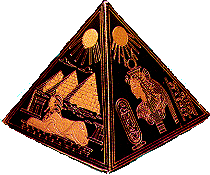
An ancient Egyptian's wealth was measured in cattle rather than in coins.
Ancient Egyptian society was shaped rather like a pyramid. The pharaoh was at the top, then came the vizier or chief minister who organised taxation, supervised agriculture and irrigation systems and represented the pharaoh in the law courts. There were other powerful members of government who often belonged to the royal family and nomarchs who were in charge of a region or nome. Women could own property, but they did not take part in government business. All scribes and officials were respected because they could read and write. Temple priests were also honoured citizens. Craftspeople occupied a lower place in society. Peasants, who grew food and worked as labourers on the royal buildings, formed a large group at the bottom of the social pyramid. Slaves, captured in war, had no rights at all. People thought that the gods gave them their positions in society.
The layers of Egyptian society
royal family
courtiers, civil servants, generals, high priests
scribes, government officials, priests, priestesses, doctors, engineers, soldiers
craft workers, professional mourners, dancers, servants
peasants and labourers
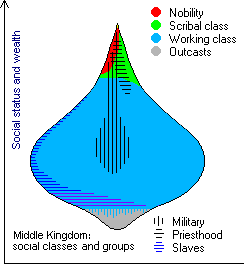
DID YOU KNOW: Peasants and labourers made up about 85% of the Egyptian society but had very few rights as citizens.
![]()
The Nile River
"The Gift of the Nile"
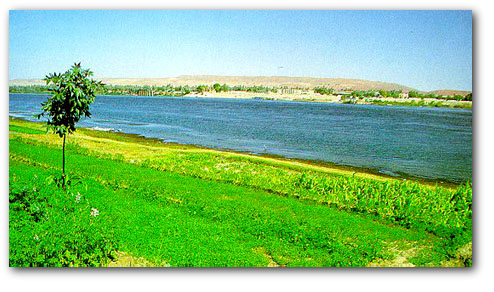 |
The Nile River is the longest river in the world, stretching for 6,500 km (4,187 miles) from East Africa to the Mediterranean. The Nile flows from south to north and is formed by three major tributaries: the White Nile, the Blue Nile and the Atbara. |
| The Blue Nile has its source in the highlands of the African country of Ethiopia, by Lake Tana. The runoff from spring rain and melting snow caused the annual summer flood of the Nile that the Egyptians depended on for water to irrigate their crops, and deposit fertile top soil. | |
| There are four major
cataracts along the Nile River. The location of these can be found on a
map by clicking here.
The Nile River receives a yearly inundation or flood between June and September. |
|
|
Seasons of the Nile River:
When the Nile failed to rise or when it rose too much, it caused hardship even during the most prosperous periods. Furthermore, when the climatic disturbances in the Nile's catchment area were prolonged, the whole fabric of society was in jeopardy. |
|
|
|
| Given the importance of the Nile flooding and its regularity, it is no wonder that the Egyptians began measuring the rise of the Nile, probably even before historic times, in order to predict the harvest. | |
| At first these records were little more than marks on the river bank, but later marked stairs, pillars or wells were built and records of the measurements kept. | |
| The most important nilometer lay on the island of Elephantine, others were built at different times at Philae, Edfu, Khenu, Memphis, Heliopolis ("sun city" in Greek), Buto and other places. |
|
Hymn to the Nile
Hail to thee, O Nile! Who manifests thyself over this land, and comes to give life to Egypt! Mysterious is thy issuing forth from the darkness, on this day whereon it is celebrated! Watering the orchards created by Re, to cause all the cattle to live, you give the earth to drink, inexhaustible one! Path that descends from the sky, loving the bread of Seb and the first-fruits of Nepera, You cause the workshops of Ptah to prosper!

DID YOU KNOW: After sunset, Nile sailing ships stayed in their moorings because the sailors could not see the shifting sandbanks in the dark.

DID YOU KNOW: People in modern times have likened ancient Egypt to a lotus plant, with its valley as the stem and its delta as the flower. The lotus, which opens at sunrise and closes at sunset, symbolises rebirth.
DID YOU KNOW: The Black Land is the name given to the fertile soil in the River Nile valley and delta. The Egyptians called this land kemet.
![]()
Egyptian Marriages
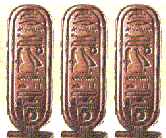
A
bride would be young, about 12 to 15 years old. Her husband could be anywhere
from 14 to 20—or older if he was divorced or a widower. The ancient Egyptians
were encouraged to marry young, considering that the life span at this time was
relatively short.
Many
marriages were arranged with parental consent needed, as they have been in all
societies, especially among the upper classes. However, the abundance of love poetry
between young people signifies that many couples did fall in love and chose
each other as mates. Women played a large role in arranging a marriage. A suitor
sometimes used a female go-between to approach the girl’s mother—not her
father.
Interestingly,
one of the most affectionate titles you could call your love was
"brother" or "sister" in ancient Egypt. This had nothing to
do with sibling relations, but led many archaeologists and scholars to wrongly
assume that most ancient Egyptians married their siblings. Actually, this
usually occurred only among royalty—and was not a common occurrence.
The Wedding Day
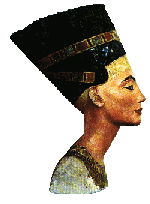
The
day of the marriage was really quite simple. The bride merely moved her
belongings into the home of her husband. He might be living alone or with his
parents.
So
what did the bride wear? She probably wore a long dress or tunic made of linen,
which may have been covered from head to toe with bead-net. If she owned any
gold, silver or lapis, she probably adorned herself with those, too.
Even
though there was no official ceremony, knowing how much the ancient Egyptians
loved music, dance and food, there were bound to be family celebrations in
honour of the uniting couple.
Entering
into a marriage was described as 'making a wife' or 'taking a wife', but it
seems that the girl's father had the main say. If the girl had no father, an
uncle would step in. In the absence of any pre-existing agreement, it seems that
the girl's consent to a marriage was unimportant until the 26th dynasty, when
brides also began to have a say.
A
man could marry as soon as he was physically mature and had reached a point in
his chosen career that ensured his ability to provide for his wife and for the
children they could expect.
Most
Egyptians were content to have only one wife. Marriage was an expensive matter
for the man, and the whole contract system provided such far-reaching safeguards
for the material rights of wives and children that most men could only afford
one wife at a time.
Marriages were most often between people of the same social class, but there seems to have been little regard given to race or even nationality. It was not unusual for a northern Egyptian to marry a Nubian, or someone even from another country.
Marriage
contracts do not generally tell the age of the parties, but we know from other
documents that marriage almost always occurred after sexual adulthood. The
average age for girls to enter puberty was 12 to 13, and around 14 for boys.
Indeed boys, who had to achieve some work abilities in order to support a wife
and future children, were usually 15 or over before contemplating marriage.
If the marriage ended in divorce, the rights of the wife were equally protected.
Generally, she was entitled to support from her husband, especially if she was
rejected by him through no fault of her own. The amount might equal one third of
the settlement or even more. If the bride ended up committing adultery (which
was extremely frowned upon for both men and women), she still had certain rights
to maintenance from her former husband. Monogamy, except for some of the higher
classes and royalty, seemed to be the rule for most ancient Egyptian couples.
Particularly during the early periods of ancient Egypt, the future husband made a payment to the bride's father, usually amounting to about the cost of a slave. Later, this practice was abandoned and later the practice was reversed where often the father of the bride had to compensate the future husband for her upkeep. However, if divorce occurred, the husband was obligated to continue some support to his ex-wife, usually amounting to about one third of his earnings.
Marriages
between kin were familiar among the common folk. Step-brothers and sisters
married, as did uncles and nieces quite frequently, and cousins still more so. Between very close blood-relations, however, it was exceptional among ordinary
people.
The
tradition of brother/sister or father/daughter marriages was mostly confined to
the royalty of Egypt. In tales from Egyptian mythology, marriage between
brothers and sisters and fathers and daughters were common from the earliest
periods, and so Egyptian kings may have felt that it was a royal thing to do.
However, there are also theories that brother/sister marriages may also have
strengthened the king's claim to rule.
Divorce
Divorce
was as easily initiated as marriage. Divorce could be brought about by either
party; it was a private matter and the government took no interest in it.
The
most common reasons for a husband to divorce his wife included the inability to
bear children, especially a son; the desire to marry someone else or that she
simply stopped pleasing him. A woman could divorce her husband for mental or
physical cruelty or adultery. In some cases, if the woman chose to divorce, she
forfeited her right to communal property.
Courtesy of www.kingtutshop.com